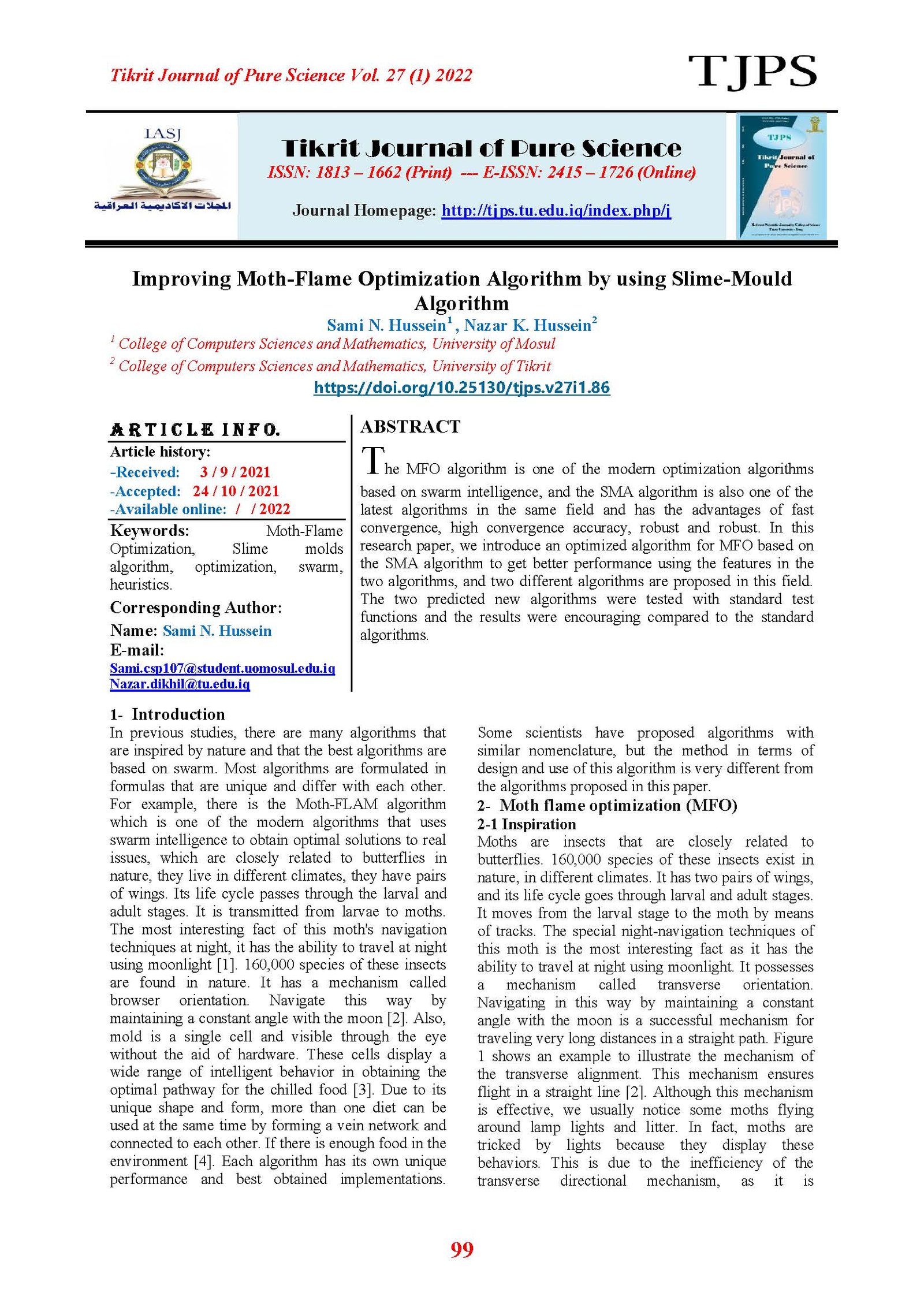Improving Moth-Flame Optimization Algorithm by using Slime-Mould Algorithm
Main Article Content
Abstract
The MFO algorithm is one of the modern optimization algorithms based on swarm intelligence, and the SMA algorithm is also one of the latest algorithms in the same field and has the advantages of fast convergence, high convergence accuracy, robust and robust. In this research paper, we introduce an optimized algorithm for MFO based on the SMA algorithm to get better performance using the features in the two algorithms, and two different algorithms are proposed in this field. The two predicted new algorithms were tested with standard test functions and the results were encouraging compared to the standard algorithms.
Article Details

This work is licensed under a Creative Commons Attribution 4.0 International License.
Tikrit Journal of Pure Science is licensed under the Creative Commons Attribution 4.0 International License, which allows users to copy, create extracts, abstracts, and new works from the article, alter and revise the article, and make commercial use of the article (including reuse and/or resale of the article by commercial entities), provided the user gives appropriate credit (with a link to the formal publication through the relevant DOI), provides a link to the license, indicates if changes were made, and the licensor is not represented as endorsing the use made of the work. The authors hold the copyright for their published work on the Tikrit J. Pure Sci. website, while Tikrit J. Pure Sci. is responsible for appreciate citation of their work, which is released under CC-BY-4.0, enabling the unrestricted use, distribution, and reproduction of an article in any medium, provided that the original work is properly cited.
References
[1] Frank, K. D., Rich, C., & Longcore, T. (2006). Effects of artificial night lighting on moths. Ecological consequences of artificial night lighting, 305-344.
[2] Mirjalili, S. (2015). Moth-flame optimization algorithm: A novel nature-inspired heuristic paradigm. Knowledge-based systems, 89, 228-249.
[3] Li, S., Chen, H., Wang, M., Heidari, A. A., & Mirjalili, S. (2020). Slime mould algorithm: A new method for stochastic optimization. Future Generation Computer Systems, 111, 300-323.
[4] Monismith, D. R., & Mayfield, B. E. (2008, September). Slime mold as a model for numerical optimization. In 2008 IEEE swarm intelligence symposium (pp. 1-8). IEEE.
[5] Kessler, D. (1982). Plasmodial structure and motility. Cell biology of Physarum and Didymium /edited by Henry C. Aldrich, John W. Daniel
[6] Nakagaki, T., Yamada, H., & Ueda, T. (2000). Interaction between cell shape and contraction pattern in the Physarum plasmodium. Biophysical chemistry, 84(3), 195-204.
[7] Beekman, M., & Latty, T. (2015). Brainless but multi-headed: decision making by the acellular slime mould Physarum polycephalum. Journal of molecular biology, 427(23), 3734-3743.
[8] Latty, T., & Beekman, M. (2015). Slime moulds use heuristics based on within-patch experience to decide when to leave. The Journal of experimental biology, 218(8), 1175-1179.
[9] Nakagaki, T., Yamada, H., & Ueda, T. (2000). Interaction between cell shape and contraction pattern in the Physarum plasmodium. Biophysical chemistry, 84(3), 195-204.
[10] Eberhart, R., & Kennedy, J. (1995, November). Particle swarm optimization. In Proceedings of the IEEE international conference on neural networks (Vol. 4, pp. 1942-1948).
[11] Sharma, M., Bansal, R. K., Prakash, S., & Asefi, S. (2021). MVO algorithm based LFC design of a six-area hybrid diverse power system integrating IPFC and RFB. IETE Journal of Research, 67(3), 394-407.
[12] Mirjalili, S., Mirjalili, S. M., & Lewis, A. (2014). Grey wolf optimizer. Advances in engineering software, 69, 46-61.
[13] Yang, X. S., & Deb, S. (2009, December). Cuckoo search via Lévy flights. In 2009 World congress on nature & biologically inspired computing (NaBIC) (pp. 210-214). Ieee.
[14] Husein I., Riski A., Pradjaningsih A, (2020), "Application of Whale Optimization Algorithm (WOA) on Quadratic Knapsack 0-1 Problem "E-ISSN: 2580-5754,P-ISSN:2580-569X, Vol. 4, No. 1,pp. 13-20
[15] Heidari, A. A., Mirjalili, S., Faris, H., Aljarah, I., Mafarja, M., & Chen, H. (2019). Harris hawks optimization: Algorithm and applications. Future generation computer systems, 97, 849-872.
